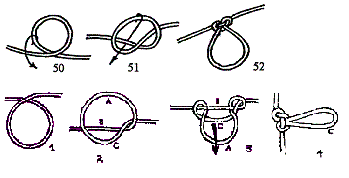 |
Marlinespike Hitch or Ladder hitch
A temporary hitch made with the aid of a marlinespike, a tent peg or other suitable object, when extra strain is needed to heave a small rope taut, as, for example, the runs of a lashing. Made in hand, without a marlinespike, it can be used for grater security in a Sheep Shank or Harvester�s Hitch. The form of the hitch will be apparent from Fig 56. To make it with a spike, lay the spike on the rope and rotate it to make a turn in the rope (53:54). Turn the spike over so as to fold the turn over the standing part (54:55) and then stick it under the bight and up (55). The spike can now be used for a direct pull or as a lever with the point pressing on a fixed object, eg. For tighting frapping on a lashing. Another use for this hitch is as a crossing knot in temporary fencing. Rope ladders or rope barriers: in this case it is usual to make the knot in hand and drop it over the post, finally heaving tight. |













